Storm Preparedness & Safety Tips
Wet weather is in store for the Bay Area through the evening. It’s important to know what to do to be safe and prepared in the event this healthy dose of rain causes any hazardous situations. Here’s a run-down of the basics to storm prep and safety:
- Check your supplies and make sure you have what you need on hand: http://www.sf72.org/supplies.
- Check on friends and family who may need assistance during the storm.
- Remove debris and sweep up any leaves from sidewalks and storm drains to keep them from getting clogged.
- Call 3-1-1 (or use the SF311 app) for non-life threatening storm issues. Call 9-1-1 for emergencies: www.maketherightcallsf.org
- Sign up for AlertSF by texting your Zip Code to 888-777 for real-time emergency alerts.
- Sandbags are available at 2323 Cesar Chavez St, daily, from 7:00 AM to 4:00 PM.
- If the power goes out, unplug and turnoff appliances. Leave one light on to signal when power is restored.
- Avoid using candles because they are a fire hazard, especially in San Francisco due to so many wood buildings.
- Have flashlights and extra batteries on hand.
- Stay away from flooded areas and downed power lines whether in car or on foot.
- Do not touch electrical equipment if you are wet or standing in water.
- Stay informed: tune-in to KCBS (740 AM or 106.9 FM), local TV channels, or social media (@sf_emergency; @sfwater; @sfpublicworks; @sfdph ) for emergency advisories and instructions.
- Please share this information with your family and friends.
DEM Recognized for UPS Active Shooter Incident Emergency Response
On the morning of June 14th tragedy struck our City. A senseless act of gun violence stole three people from their families and our community. We all have some connection with the women and men of UPS who have become part of our everyday lives while dutifully delivering packages in their trademark brown uniforms. This tragedy has left us all mourning the loss of San Francicos’ UPS delivery drivers Wayne Chan, Benson Louie, and Michael Lefti. Yet, we find comfort that further tragedy was prevented by the prompt and professional actions of our public safety community.

Today, Mayor Ed Lee recognized those who responded to the UPS shooting, including two DEM employees: Anastacia (Staci) Byrne, the DEM Public Safety Dispatcher who received the initial 9-1-1 call; and Tom Chin, the DEM Emergency Services Coordinator who immediately activated the Emergency Operations Center to support the overall emergency response. Although not on-scene, Staci and Tom made sure those ‘on the ground’ had the situational awareness and resources needed to effectively respond to this dire and dangerous situation while fulfilling the following vital emergency response roles:
It was Anastacia (Staci) Byrne who received the initial emergency call from frightened UPS employees reporting an active shooter in the UPS facility on San Bruno Avenue. The employees were huddled in a conference room and unsure of what to do. Staci quickly told them to barricade themselves in the conference room. As she remained on the phone—all the while providing instruction and updates— the UPS employees and Staci became a team. The employees shared information about the building’s layout that helped police and fire responders navigate on-scene. Staci stayed on the line until police units were able to safely evacuate the employees from the building.
Tom Chin immediately activated San Francisco’s Emergency Operations Center (EOC) within minutes of receiving notice of an active shooter event. The EOC’s role was to provide support to first responders and services to people affected by the active shooter incident. As a result of his efforts, San Francisco was able to coordinate efforts to track shooting victims, provide family and mental health resources, and disseminate safety alerts to the public. In the days following the event, Tom coordinated and facilitated daily incident management calls to ensure UPS employees received the assistance they needed to recover from this tragedy.
More about Anastacia (Staci) Byrne:
Staci has been a Public Safety Dispatcher with the Department of Emergency Management for 12 years. She moved to San Francisco as a small child, was raised Visitacion Valley, and graduated from Mercy High School. Her father is a retired Army Officer who dedicated his life to serving his country, so it comes as no surprise that Staci has chosen to serve the citizens, visitors, and public safety partners of San Francisco. Staci was a chef before becoming a Public Safety Dispatcher (experience that really enhances DEM pot lucks!). She was encouraged to become a police officer, but chose to be a 9-1-1 Dispatcher instead.
More about Thomas Chin:
Tom has been an Emergency Services Coordinator with the Department of Emergency Management for four years. In his current role, he manages the development of emergency plans and also staffs the Emergency Operations Center (EOC) during planned and unplanned events. Prior to joining the department, Tom worked for Santa Clara County Public Health providing emergency preparedness and public health education services. Tom earned his Bachelor of Sciences in Public Health from San Francisco State University. Tom and his family have deep roots in San Francisco’s Excelsior neighborhood. He is a lifelong Bay Area sports fan and actively cheers on the Giants, Warriors, and 49ers. Tom and his wife, Raine, reside in San José.
Making the Right Call
When someone dials 9-1-1 it’s for a medical or fire emergency, or a crime in progress. These are very serious and scary situations, and our City’s 9-1-1 dispatchers are experts at sending the right kind of help to the right location–fast.

Call 9-1-1 to receive help for emergencies, potential emergencies, or if you are not sure if it’s an emergency.
But sometimes people call 9-1-1 for things that are not emergencies, like reporting stolen property or someone loitering. Although these types of situations are serious and should be reported, calling 9-1-1 for non-life and non-property threatening situations ties up our 9-1-1 phone lines and makes it harder for real emergency calls to get through. So, if you need Police assistance but are not experiencing a crime in progress, please call the San Francisco Police Department’s non-emergency phone line: 415-553-0123. Please note that this line is answered as quickly as possible—after calls to 9-1-1. If your call is not answered immediately, it’s because our 9-1-1 dispatchers are handling priority emergency medical, fire, or criminal activity calls that can result in lives being saved and crimes being stopped.
From time to time our City’s 9-1-1 dispatchers also receive calls for things that are not emergencies like reporting a blocked driveway or how to access a City service. For these circumstances, it’s best to dial 3-1-1 where expert staff can provide information on a variety of non-emergency City services, both over the phone and on the 311 app. And just like 9-1-1 and 415-553-0123, they are available 24 hours a day, seven days a week.
Before you dial 9-1-1 keep in mind the nature of your call. Is it an emergency that requires immediate medical, fire, or police response? If so, or even if you’re not sure, dial 9-1-1. Is it something that should be reported to the Police but is not a crime in progress? Then please call the San Francisco Police Department non-emergency line at 415-553-0123. And if you have general questions or need to report a situation needing city services, call 3-1-1. You could be saving someone’s life by making the right call when it comes to dialing 9-1-1.
The San Francisco 9-1-1 Dispatch Center is a division within the San Francisco Department of Emergency Management, which leads the City in planning, preparedness, communication, response, and recovery for daily emergencies, large-scale citywide events, and major disasters. To learn more about the San Francisco Department of Emergency Management visit http://www.sfdem.org.
Who Handles Information During a Disaster?
As emergency managers we are tasked with preparing for large incidents, responding to them and helping our communities recover after they occur. More specifically, as Public Information Officers (PIOs or public affairs personnel) we are the handlers of information that flows in and out of our Emergency Operations Center (EOC). We often are charged with receiving and vetting information, creating messaging and making sure crucial information gets to our communities. Information might include where emergency shelters are, evacuation orders or where you can find potable water and food.


We have a saying in emergency management, “never exchange business cards during a disaster.” To ensure that doesn’t happen, we brought together local and state PIOs to discuss how we develop and share information with the public during an emergency. In San Francisco, we coordinate this through Emergency Support Function #15: the Joint Information System (JIS) plan. The JIS provides a framework for how we’ll communicate with our partners and the public in the City after an emergency.

We not only wanted to discuss how we’d work together within this framework, but we also wanted to learn about each other’s capabilities and resources. It’s important to get an idea of what we can really expect from one another in an emergency. This workshop was the first in a series leading up to our annual Fleet Week disaster response exercise that we conduct with the local first responders, state and federal emergency officials, and the military. This year we’ll review how to setup Field Care Clinics, request mutual aid from the state and work with federal capabilities and assets following M 7.9 earthquake on the San Andreas Fault.
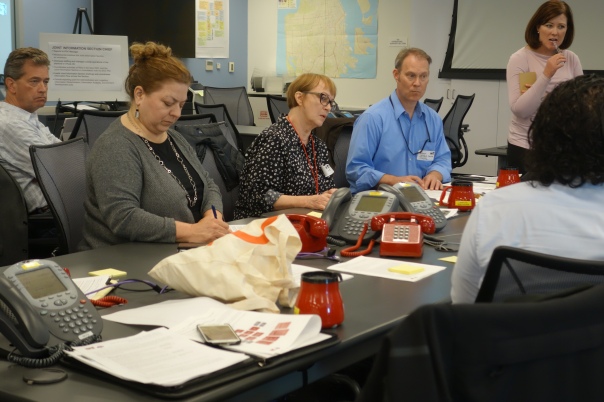
2016 Dispatcher of the Year!
San Francisco’s 9-1-1 dispatchers selected Janet Atchan as the 2016 Dispatcher of the Year. Janet coordinated the emergency response to the shooting of San Francisco Police Officer Kevin Downs by a fleeing suspect. In addition to the award, Janet received a commendation from the San Francisco Board of Supervisors.
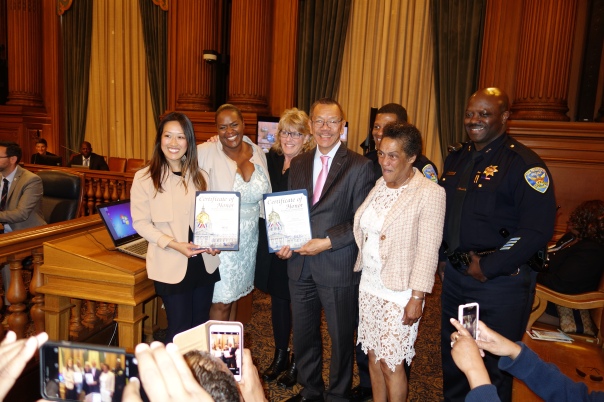
“Janet Atchan is a deeply committed and caring 9-1-1 dispatcher. When a police officer’s life was on the line she worked diligently to get him the help he needed while making sure resources were in place to keep fellow responders and the public safe,” said Anne Kronenberg, Executive Director, San Francisco Department of Emergency Management (SFDEM). “We see Janet’s example every day when our talented team of dispatchers take calls or coordinate emergency resources.”

On the evening of October 14, 2016, San Francisco’s 9-1-1 dispatchers received calls from the public about a man acting erratically in the Lakeshore Plaza Shopping Center on Sloat Avenue in San Francisco. Janet Atchan was serving as a radio dispatcher at the time and it was her responsibility to maintain contact with police officers once they exited their vehicle. The officers communicated they had arrived and located the person of interest. Minutes had passed before Janet heard one of the worst things any emergency responder could hear over the radio “Officer Down, Shots Fired”. Between the officers’ arrival and the radio transmission, the suspect ran away from officers and shot at them striking Officer Downs in the head.
Janet immediately sent additional police officers and emergency medical services to assist Officer Downs. Her responsibilities included setting up a police escort for the ambulance as it made its way to Zuckerberg San Francisco General Hospital. Janet then joined her partner, Dispatcher David Solis, in establishing a perimeter to contain the suspect as officers searched for the armed suspect in the surrounding neighborhoods. The suspect was apprehended after exchanging gun fire with police officers near Stern Grove in San Francisco’s Sunset District. By the time the incident ended Dispatcher Atchan had stood her post well beyond the hours of her shift.

The Dispatcher of the Year is elected by their fellow dispatchers for extraordinary performance while answering 9-1-1 calls or dispatching emergency services. Janet shares this honor with her fellow dispatchers who provide vital ongoing support, which is indispensable to the entire San Francisco dispatchers team during crucial calls.
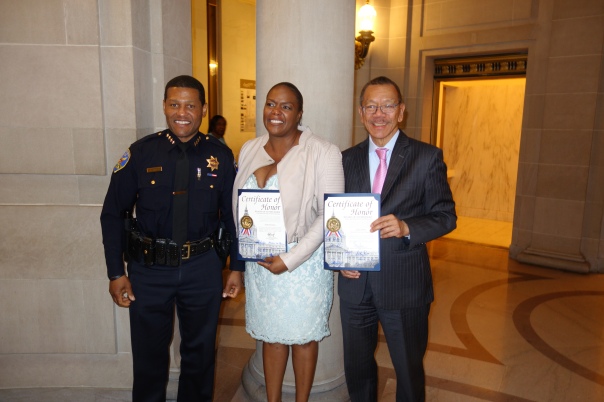
Janet Atchan is a fourth-generation San Franciscan and was raised in San Francisco’s Fillmore neighborhood. She’s spent the last 25-years serving as a 9-1-1 professional. During her career, Janet earned her bachelor’s degree in Sociology from UC Berkeley and her MBA from the University of San Francisco.
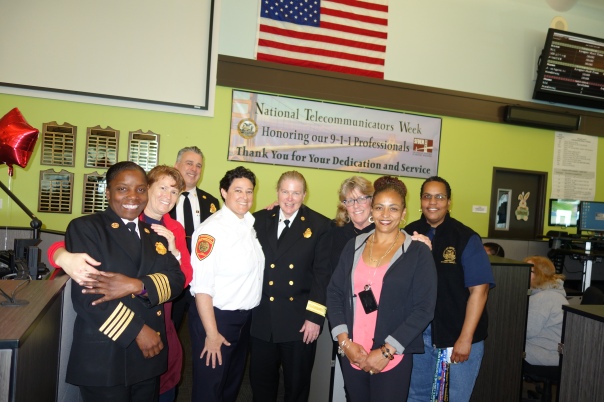
San Francisco receives more than 1.2 million emergency and non-emergency calls annually. 9-1-1 professionals dispatch police, fire, and medical assistance to the scene of accidents, crimes, fires, and other emergency and non-emergency situations. In addition to taking calls from the public, dispatchers act as the communications hub for emergency services and must quickly assess situations to determine the appropriate resources to dispatch, making them the San Francisco’s first, first responders.
A Dispatcher By Day, Weightlifter by Night
When you think of first responders, you probably picture paramedics, emergency medical technicians (EMTs), firefighters and police officers. But there’s a first first responder behind the scenes who handles things before those folks get involved: the 9-1-1 dispatcher.
Public Safety Dispatcher Delanie Groll has been with the Department of Emergency Management for six years and a dispatcher for nine. But Delanie was introduced to the world of emergency services much earlier. She and her two sisters came from a public safety bloodline; her father was a firefighter for Contra Costa County and her mother worked at Oakland’s Department of Emergency Services.
Her favorite thing about being a dispatcher? It challenges her. However, the biggest challenge in her life right now, is her nerves as she’s a month and a half away from participating in the National Masters Weightlifting Championship in Georgia on Friday March 10th – Sunday March 12th, 2017.

Delanie fell in love with weightlifting after going to the gym and taking part in CrossFit in 2010. Her sinewy frame is a testament to the grueling daily training sessions that include clean-and-jerk and snatch lifts or core and strength training. When the women at her gym suggested participating in the qualification round for the national competition in Georgia, she felt noncommittal. Little did she know, she qualified!

A dispatcher by day and weightlifter by night, her work-life balance is packed with long days. Her training regimen and diet requires a fine sense of control and discipline. But she trains with people who motivate her to keep going and engage her competitive spirit which helps propel her further. That’s the key to her two consistent years of weightlifting; community. The weightlifting community that she’s found keeps her focused, on track and crushing.

Delanie Groll reminds us all that dispatchers are more than the calm voice on the phone. They have dreams and goals. It is a reminder that we are more than our occupations, we are what challenges us, what liberates us, and what ignites our spirit. Our worth isn’t defined by how much we do or don’t accomplish. What matters most is how committed you stay to your #goals and those who you inspire on the way up. And for Delanie Groll, she’s inspired many at DEM. DEM will be cheering her on all the way to the National Masters Weightlifting Championship.
San Francisco Department of Emergency Management Accepts New Applications for 9-1-1 Dispatchers
San Francisco Department of Emergency Management
Accepts New Applications for 9-1-1 Dispatchers
Applications accepted beginning Monday January 9, 2017
San Francisco, C.A. – The San Francisco Department of Emergency Management invites all interested and qualified persons to submit an application for the opportunity to become a Public Safety Communications (9-1-1) Dispatcher. Dispatchers are the vital link between the public and police officers, firefighters, and medics during emergency situations. Interested persons may apply beginning Monday January 9, 2017.
“San Francisco’s 9-1-1 Dispatchers perform difficult and life-saving work to help people in emergency situations. This career requires a commitment to serving the community and the understanding that your work may involve personal sacrifice,” said Anne Kronenberg, Executive Director, San Francisco Department of Emergency Management (SFDEM). “This life is not for everyone. However, if you value public service you will find this career rewarding and we encourage you to apply.”
Dispatchers answer all emergency (9-1-1) and non-emergency (415-553-0123) calls in San Francisco. They also dispatch and coordinate police, fire, and emergency medical services over a two-way radio system using a computer aided dispatch system. This work is performed 24 hours-a-day, 7 days-a-week, 365 days-a-year. Dispatchers may be assigned to work various schedules, which include day shift, swing shift, night shift, weekends, holidays, and overtime. Dispatchers work 8-hour or 10-hour shifts, or longer, and must be willing and able to respond, report, and mobilize as necessary. The base salary for a Public Safety Communications Dispatcher begins at $81,558 annually.
Applicants must verify they meet the minimum qualifications and pass a performance and oral examination in order to be placed on the recruitment list for the Dispatch Academy. The minimum qualifications for a Public Safety Communications Dispatcher are two years of experience in a public contact position and possession of a High School Diploma, General Education Development (GED) or High School Proficiency Certification.
The performance exam measures an applicant’s ability to prioritize and multitask effectively in a fast-paced, high stress environment; recall facts, details and other pertinent information; and the ability to operate a computer terminal while typing at a minimum speed of 35 words per minute.
Those who pass the performance examination are invited to participate in a scenario-based oral examination. This exam tests oral and written communication skills, the ability to collect information and make sound decisions, aptitude to perform several tasks simultaneously, and interpersonal skills.
People who meet the minimum qualifications and pass both examinations are placed on the eligible list by rank. Candidates on this list must undergo extensive employment, character, and background investigations. Candidates must also undergo a polygraph examination, psychological evaluation, and medical examination prior to appointment to the Dispatcher Academy.
“San Francisco has an extensive screening process to ensure that people have the basic skills, temperament, ability, and integrity for the opportunity to become a dispatcher,” said Sandy Chan, Human Resources Manager, SFDEM. “It can take up to nine months to effectively screen applicants. For this eligible list the earliest a candidate could be appointed to the academy is September 2017.”
Prospective dispatchers must complete the eight week Police Officers Standards and Training (POST) Academy for public safety dispatchers where they must display mastery of subjects including police, fire, and medical procedures, radio codes, and geography of San Francisco. Upon graduation from the academy, dispatch trainees receive on-the-job training first by answering live 9-1-1 calls and then dispatching police, fire, and medical services. This training takes place under the watchful eye of a veteran dispatcher and may last up to nine months. It is during this phase of training when most trainees drop out or are released by SFDEM.
“People quickly realize they are dealing with real life while taking actual emergency calls and start sending first responders to an emergency,” said Robert Smuts, Deputy Director for Emergency Communications (9-1-1), SFDEM. “Becoming a dispatcher is a rigorous process designed to ensure you have the skills and emotional intelligence to help people on their worst days.”
To learn more about how to apply to become a Public Safety Dispatcher, visit https://www.jobaps.com/SF/sup/BulPreview.asp?R1=CCT&R2=8238&R3=073737
***********************************************************************
Tips on the Application Processes
· Be honest with yourself before you apply. Being a San Francisco Public Safety Communications Dispatcher is a rewarding career for those with a genuine passion for public service. Applicants should know a dispatcher’s work is demanding and difficult. Most junior dispatchers work nights, weekends, and holidays and this may continue well into your career. You may also be called upon to work overtime or come in your days off due to an emergency.
· Applications for City and County of San Francisco jobs are only accepted through an online process. Visit http://www.jobaps.com/sf to register an account (if you have not already done so) and begin the application process.
· For those without online access at home, computers are available to the public to file online applications 8:00 a.m. to 5:00 p.m. Monday through Friday in the lobby of the Dept. of Human Resources at 1 South Van Ness Avenue, 4th Floor, San Francisco.
About SFDEM
The San Francisco Department of Emergency Management (DEM) leads the City in planning, preparedness, communication, response, and recovery for daily emergencies, large scale citywide events, and major disasters. DEM is the vital link in emergency communication between the public and first responders, and provides key coordination and leadership to City departments, stakeholders, residents, and visitors. For more information visit www.sfdem.org.
About 9-1-1
San Francisco receives more than 1.2 million emergency and non-emergency calls per year or an average of more than 3,400 per day. Since 2011, San Francisco has experienced a 37 percent increase in call volume with dispatchers answering 1,000 more calls a day than they did five years ago.
The San Francisco Department of Emergency Management (SFDEM) is committed to increasing the number of 9-1-1 professionals answering calls and dispatching emergency services. In Fiscal Year 2013-2014, the Department of Emergency Management began a hiring initiative to keep pace with increased call volume. Last year, we hired 23 new Public Safety Communications Dispatchers.
9-1-1 Telephone System Upgrade
This is an exciting time for DEM, this week we are upgrading our entire 9-1-1 telephone system! After 16 years, our old telephone and trunk system is well beyond its useful life. Not only is the phone system outdated, the current system has limited technical support and much of its replacement parts are no longer available. Can you imagine using the same phone today that you had in 2000? Cell phone or landline, technology has far surpassed the abilities of the system we’ve been waiting to retire.

Dispatchers are trained to pull and assess information from a caller so the right level of help can be sent quickly.
Why is the 9-1-1 telephone cutover important?
Hopefully you’ve never had to call 9-1-1, but if you did I bet you’d hope that the phones were up and running! Not only is the new system more reliable, it prepares San Francisco for Next Generation 9-1-1 once the State of California Office of Emergency Services finalizes their roadmap for migration.
Next Generation 9-1-1 allows the 9-1-1 system to keep up with communications technologies used by the public. For instance, how do you communicate these days with friends and family? Do you like to text? Do you ever send videos? Maybe you prefer sending pictures. Next Generation 9-1-1 will allow us to accept emergency calls, videos, texts and pictures. Having this capability within the new 9-1-1 telephone system ensures that we’ll be able to keep up with the people that are the most important to us, you!

Call 9-1-1 to receive help for emergencies, potential emergencies, or if you are not sure if it’s an emergency.
What have we done to get ready for the upgrade?
Ensuring that the 9-1-1 system is available for anyone that needs it in San Francisco is our top priority. This is why we have conducted extensive testing since the beginning of the summer. This is also why we’ve made sure that extra personnel and resources will be available to manage the transition. This includes technical support staff and additional dispatchers to manage emergency calls should the need arise. If an issue develops that may potentially impact public safety, contingency plans are in place to ensure that the 9-1-1 system remains online. Our contingency plans may include reverting back to the old system or using our backup 9-1-1 telephone system.

What can people expect when they call 9-1-1?
The first set of 9-1-1 callers may experience a brief echo at the beginning of calls as the phones calibrate to the new system. However, after that people calling 9-1-1, the dispatchers answering phones, and police officers, fire fighters, and medics responding should not notice any difference during or after the 9-1-1 telephone system upgrade.
Background:
The San Francisco Department of Emergency Management coordinates the response to everyday and not-so-everyday emergencies. Our 9-1-1 public safety dispatchers answer the phone and send help when there is a police, fire, or medical emergency. The 9-1-1 system is the critical lifeline between the public and city’s first responders.
Emergency Management Mutual Aid Requests: Soberanes and Lake County Fire Deployments
The 2016 California Wildfire season has seen more than 6,700 fires which have burned more than 560,000 acres. For many people, this means the loss of a home, property, or livelihood. As local emergency managers, it’s our responsibility to not only coordinate the response but to help our communities recover. In Monterey and Lake Counties local emergency managers were there for their communities but were often left wondering if their own homes had made it through. When we had the opportunity to provide them some relief so that they could check on their homes, our team was happy to lend a hand. This year we sent staff to both Monterey County for the Soberanes Fire and Lake County to assist in the Clayton Fire response and recovery efforts.
What triggers a staff deployment? The State of California issues an Emergency Management Mutual Aid request (EMMA). When a city or county has exhausted all of their resources (staff and assets) to respond to an emergency, they ask the State to reach out to the closest neighboring cities and counties for aid, be it fire trucks or staff.
Lisa Starliper, our Emergency Planning Manager and Tom Chin, our Response Coordinator had the opportunity to deploy to the Soberanes Fire in Monterey County. Additionally, Daniella Cohen with our External Affairs team assisted in Lake County for the Clayton Fire response. Here are some of Lisa’s and Daniella’s reflections on their experiences, with photos shared by Tom.

CalFIRE Air Operations conducted behind Tularcitos Elementary School. In partnership with the Monterey County Office of Emergency Services, CalFIRE held a community meeting at Tularcitos to provide information and answer questions for the residents of Carmel Valley.
1. Can you share with us what you know about the EMMA process?
Lisa: My basic understanding was that whenever another city or county needed assistance, a resource request would be initiated. Following, our department would ask for volunteers to support the request. The Operations Section within SFDEM has the “lead” on managing and monitoring EMMA requests. They work to put forward the name and qualifications of any employees that are capable and available to do the work required.
Daniella: The Operations Section within SFDEM manages the EMMA requests. Lake County Office of Emergency Services (OES) needed a Public Information Officer and someone to otherwise deal with press inquiries and public information in their Local Assistance Center (LAC). As a member of the External Affairs team at SFDEM, I jumped at the opportunity to assist our partners in anyway.
2. Please share what you knew about the fire going in and what you learned as you gained more situational awareness.
Lisa: I was aware of the basic information about the fire that was available from public domains. I also had access to daily situation reports, which provided a more in-depth analysis of the current situation.
Once I was actually working in the Emergency Operations Center (EOC), I was able to increase my situational awareness through attendance at briefings and meetings. I also was able to work directly with members from Public Health regarding disaster assessment team deployments and debris management. This experience was extremely helpful in gaining a greater understanding around the issues of recovery.
Daniella: Going in I would agree with Lisa in that you can expect to be briefed with basic information about the incident upfront. I was also lucky to receive daily situation reports from Lake County OES which helped me to better understand not only what was needed, but also what would be expected of me once I arrived.
After I arrived, I realized that we were operating in the field in the middle of downtown Clear Lake where fire damage was clearly seen all around us. My experience thus far has been working inside of an EOC. It was truly humbling to be able to assist community members in this environment.

CalFIRE held multiple community meetings in the days, weeks, and months after the start of the Soberanes Fire in Monterey County. Community meetings were held in partnership with the Monterey County Office of Emergency Services and included fire suppression and behavior experts to explain the tactics and science behind the firefighting efforts.
3. What is expected of you when you deploy?
Lisa: I believe my role is to be as supportive, helpful and respectful as possible. Being a solid representative of my department and the City and County of San Francisco is just as important. On the more tangible side of things, there’s an expectation of long work hours and alternative living conditions.
Daniella: I completely agree with Lisa, you are there to provide support and to be of complete disposal to local emergency managers. It presents an opportunity to not only be of service, but to learn from others around you.
4. What was it like when you first walked into Monterey County’s EOC or the Local Assistance Center (LAC) in Lake County?
Lisa: For me, it was a very positive experience. Tom Chin had done an excellent job of laying the foundation for my arrival, which made the transition from “newbie” to EOC staff member much easier. Monterey County’s EOC had a very professional atmosphere to it, which helped smooth the transition as well.
Daniella: The LAC is a hub for fire victims to seek services, initially upon my arrival the LAC was just opening for the day and naturally it was a bit overwhelming. As time wore on, a rhythm was found not only for LAC staff but for community members as well. Facing fire victims as they try to recover from enormous loss is difficult, but it was also heartwarming to see how communities band together in times of disaster.

Every morning a CalFIRE led Partner Brief provided a common operating picture among the 20 + participating agencies including the Monterey County Office of Emergency Services, US Forestry, US Fish and Wildlife, mutual aid fire agencies, California Highway Patrol, California State Parks, and the California Conservation Corps. The Partner Brief detailed the progress made overnight and the clear objectives for the upcoming day.
5. How did your roles develop, and what were your greatest lessons learned or takeaways from the experience?
Lisa: My role remained pretty constant during my time there. I was filling a technical specialist role within the Plans Section and worked on the Concept of Operations for Debris Management and Damage Assessments.
For myself, the greatest lesson learned was to see firsthand the response and recovery considerations that were required for a wildfire incident. My emergency management experience has primarily focused on terrorism, being a first responder and maritime search and rescue. All in all, it was a fantastic experience.
Daniella: Like Lisa, my role remained the same. I acted as a Public Information Officer while also providing community affairs assistance. The greatest lesson learned for me is that the field of emergency management and disaster response knows no boundaries. Regardless of jurisdiction, or city and county lines we are here to assist each other. Often times it is that team work that yields the best results, and helps communities to heal faster. I felt lucky to offer a small bit of assistance to our partners.

Eventually, the coordination to fight a fire as large as the Soberanes Fire needs technology to be efficient. A televised morning Incident Brief provided instruction to over 350 firefighting units, fire air operations, and fire safety in three (3) different locations. This Incident Brief provided a united tactical advantage to conduct safe and effective fire suppression.
Thank you to both Lisa Starliper, Daniella Cohen and Tom Chin for representing SFDEM in Monterey and Lake Counties, and assisting in their response and recovery efforts.
What on Earth is a C-POD?
On October 3rd, the San Francisco Department of Emergency Management conducted our annual disaster exercise with San Francisco Fleet Week. This year the focus was on C-PODs, otherwise known as Community Points of Distribution.C-PODS are temporary locations where the public can go to get basic necessities, such as food and water, when everyday resources are not available due to a major emergency or disaster.
The goal of a C-POD is to prevent human tragedy after a disaster. Last Monday, we practiced setting up an entire C-POD site with over 100 staff and disaster survivor volunteers. The scenario was a magnitude 7.0 earthquake, and the aftermath left residents incapable of supplying food and water for themselves. A C-POD is a last measure resort, and one that we hope to never utilize. However, if we do, we’ve received some much needed practice. Enjoy our photo blog below:

C-PODs ensure people have the basic necessities for daily nutrition and hydration, which help people to continue staying in their homes rather than having to stay at shelter sites.

C-POD Manager Bijan Karimi explains the logistical setup and goal of C-POD sites with the press.

Our partners the United States military, the San Francisco Human Services Agency and CalFire brief our staff and volunteers on the main objective behind today’s C-POD exercise: distribution and efficiency.

Military partners look on and give direction to fellow National Guard soldiers participating in the exercise.
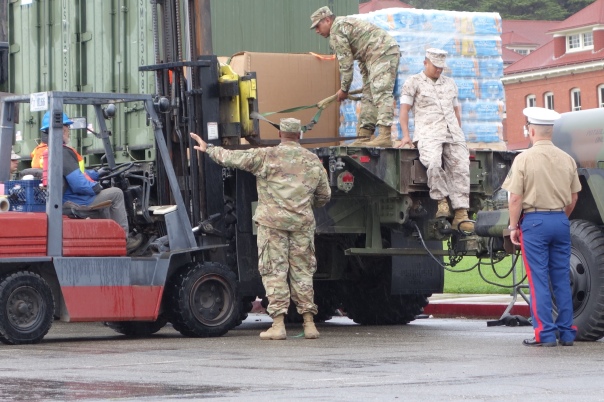
When C-POD sites become necessary we may lean on our military partners such as the National Guard, the US Navy or the US Coast Guard to bring emergency supplies via sea to the shores of San Francisco. They would essentially act as an extension of local emergency management personnel and expand our capacity to assist our community.
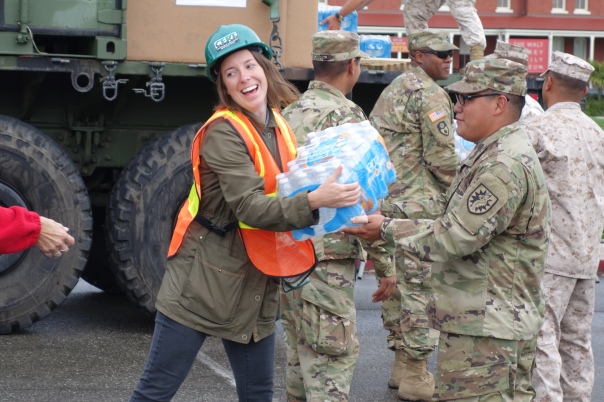
Disaster service volunteers work with our military partners to offload supplies and organize them into different PODS.
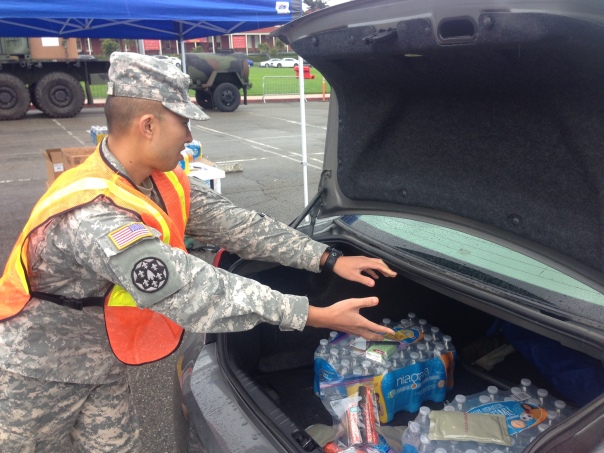
After supplies are offloaded and organized, they are put directly into the trunks of vehicles; maximizing time and efficiency to allow the service of up to 10,000 vehicles per day.
Our biggest lesson learned from our annual exercise was that we could effectively and efficiently work with our partners to setup a Community Point of Distribution following a catastrophic emergency.
Check out the sights and sounds of a C-POD:
Than you to all of our staff, volunteers and participating agencies for your support and participation in this year’s exercise.

